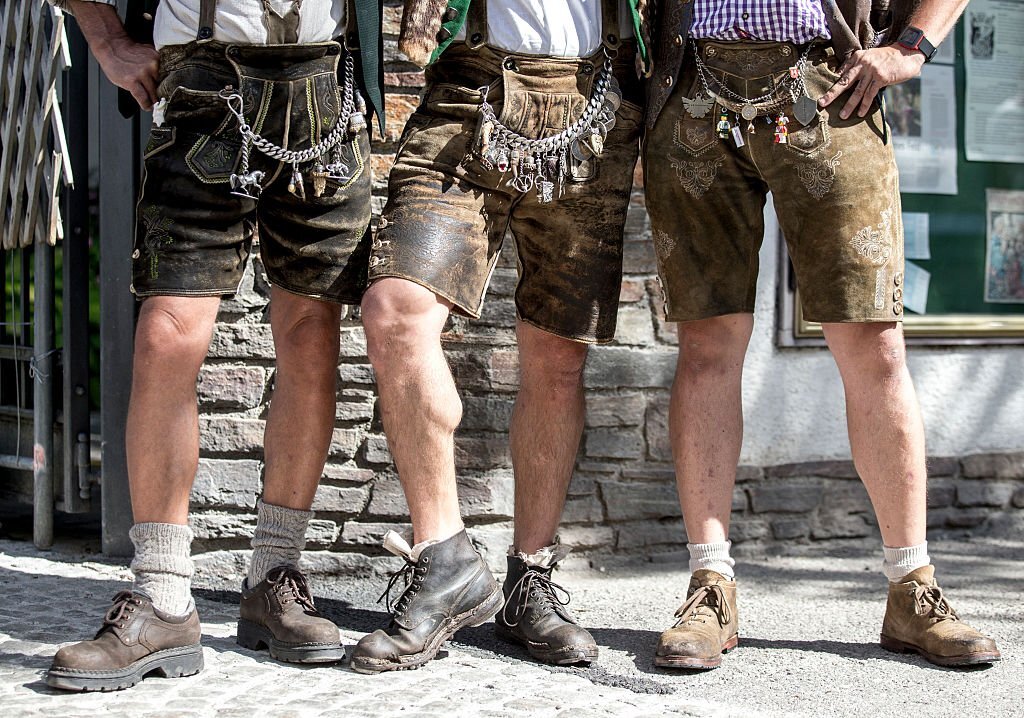Lederhosen shorts are a quintessential element of traditional German outfits, embodying a deep cultural heritage that dates back centuries. These iconic leather shorts, once a practical piece of workwear for the rural communities of Bavaria and the Alpine regions, have now become a cherished symbol of German tradition and festivity. Originally crafted for durability and functionality, Lederhosen Shorts were made to endure the rigors of everyday labor in challenging environments. Farmers, hunters, and craftsmen all relied on these tough, versatile garments as they navigated the rugged landscapes of Southern Germany and Austria. The unique qualities of lederhosen shorts, such as their resilience and ease of maintenance, made them an indispensable part of rural life. Over time, these humble work trousers have evolved into a celebrated attire that transcends their utilitarian origins, taking on a new life as festive wear at events like Oktoberfest. Today, lederhosen shorts are not just clothing; they are a cultural statement, a nod to the past, and a vibrant expression of German heritage that continues to captivate people around the world.
The Historical Origins of Lederhosen Shorts
The history of lederhosen shorts in German outfits dates back to the 16th and 17th centuries, during a time when practicality was paramount. These garments were initially designed as workwear for the rural working class, particularly in the Alpine regions of Bavaria, Austria, and Switzerland. The word “lederhosen” literally translates to “leather trousers,” and they were made from sturdy, tanned leather, typically deerskin or goatskin. This material was chosen for its durability, flexibility, and ease of maintenance. Lederhosen shorts were initially worn by peasants, hunters, and workers who needed robust clothing that could withstand harsh conditions and physical labor. Unlike other fabrics, leather provided excellent protection against the elements and was resistant to wear and tear. The shorts were also relatively easy to clean and maintain, making them ideal for those who worked in the fields or forests. The design of lederhosen shorts featured a front flap, known as the “drop front” or “Hosenlatz,” which was secured with buttons or laces. This practical feature allowed for easy access and was particularly useful for men engaged in laborious tasks. The shorts were often worn with suspenders to keep them in place, ensuring maximum comfort and mobility. Despite their utilitarian origins, lederhosen shorts quickly became a symbol of rural identity and pride. They were not just practical garments but also represented the resilience and resourcefulness of the people who wore them. Over time, lederhosen shorts evolved to include decorative elements such as embroidery and intricate stitching, reflecting regional styles and cultural significance.
The Evolution of Lederhosen Shorts in German Outfits
As lederhosen shorts transitioned from purely functional workwear to a symbol of cultural identity, they began to take on new forms and meanings. By the 18th and 19th centuries, these garments had become popular among the upper classes, who embraced them as a symbol of rustic charm and simplicity. This shift was largely influenced by the Romantic movement, which idealized rural life and traditional customs. During this period, lederhosen shorts started to be worn not only by peasants but also by aristocrats and city dwellers who sought to connect with their rural heritage. The shorts became shorter, with knee-length variations becoming particularly popular. The designs also grew more elaborate, incorporating intricate embroidery, colorful patterns, and silver buttons. These decorative elements were not just for show; they often represented specific regions or family traditions, making each pair of lederhosen shorts a unique expression of personal and cultural identity. The rise of nationalism in the 19th century further cemented the status of lederhosen shorts as an integral part of German Outfits. As people sought to define and celebrate their national identity, traditional clothing like lederhosen shorts became a powerful symbol of cultural heritage. This period also saw the establishment of traditional costume clubs, known as “Trachtenverein,” which played a crucial role in preserving and promoting traditional German outfits, including lederhosen shorts.
Lederhosen Shorts as Festive Attire
The transformation of lederhosen shorts from everyday workwear to festive attire is closely linked to the history of Oktoberfest, the world-renowned beer festival held annually in Munich, Bavaria. Originally a royal wedding celebration in 1810, Oktoberfest evolved into a massive public festival that celebrates Bavarian culture, beer, and traditional German outfits. Lederhosen shorts, with their strong ties to Bavarian heritage, naturally became the go-to attire for men attending the festival. Wearing lederhosen shorts at Oktoberfest is not just a fashion statement; it is a way to celebrate and honor Bavarian culture. The shorts are often paired with other traditional garments, such as the “Trachtenhemd” (a checkered or embroidered shirt), knee-high socks, and leather shoes known as “Haferlschuhe.” Accessories like alpine hats, belts with ornate buckles, and suspenders complete the look, making it a full-fledged traditional German outfit. The popularity of lederhosen shorts at Oktoberfest has only grown over the years, with locals and tourists alike donning them to partake in the festivities. The shorts have become a symbol of camaraderie and celebration, embodying the spirit of the event. Today, lederhosen shorts are available in a wide range of styles, from traditional designs to more contemporary interpretations, allowing everyone to find a pair that suits their taste.
Modern-Day Significance of Lederhosen Shorts in German Outfits
In contemporary times, lederhosen shorts have transcended their traditional roots and become a versatile piece of clothing that is worn for various occasions beyond Oktoberfest. They are a popular choice for cultural festivals, weddings, and even casual outings, particularly in Bavaria and the Alpine regions. The shorts have also gained international recognition, with people around the world embracing them as a fun and unique way to connect with German culture. The global appeal of lederhosen shorts can be attributed to their rich history, distinctive style, and the sense of tradition they evoke. In a world that is becoming increasingly globalized, these garments serve as a reminder of the importance of preserving and celebrating cultural heritage. They are not just pieces of clothing but symbols of a shared identity and history that connect people across generations and borders. For those looking to purchase lederhosen shorts, there are many options available, ranging from high-quality, handcrafted pieces made from genuine leather to more affordable alternatives crafted from faux leather or fabric. Whether you’re attending a traditional Bavarian event or simply looking to add a touch of German flair to your wardrobe, lederhosen shorts offer a unique and stylish option that is sure to stand out.
Lederhosen Shorts and German Outfits in Popular Culture
The influence of lederhosen shorts extends beyond traditional settings and has made its way into popular culture. From movies and television shows to music videos and fashion runways, these iconic shorts have been embraced as a symbol of German heritage and style. Celebrities and influencers often wear lederhosen shorts during Oktoberfest or other cultural events, further popularizing them and introducing them to a global audience. The adaptability of lederhosen shorts is one reason for their enduring popularity. They can be styled in various ways, from classic traditional outfits to more modern, casual looks. This versatility has allowed them to remain relevant in the ever-changing world of fashion while still maintaining their cultural significance.
How to Choose the Right Lederhosen Shorts for Your German Outfit
When it comes to selecting the perfect pair of lederhosen shorts for your German outfit, there are several factors to consider:
- Material: Traditional lederhosen shorts are made from high-quality leather, such as deerskin or goatskin, which provides durability and a comfortable fit. For a more affordable option, consider faux leather or fabric lederhosen, though these may not have the same level of authenticity and longevity.
- Fit: Lederhosen shorts should fit snugly but comfortably. They should not be too tight or too loose. Pay attention to the length as well, as lederhosen shorts typically fall above the knee.
- Style: There are various styles of lederhosen shorts, ranging from simple and traditional to elaborate and modern. Choose a style that suits your personal taste and the occasion you will be wearing them for.
- Details: Look for decorative elements such as embroidery, buttons, and suspenders that add character to the shorts. These details can reflect regional styles and make your lederhosen shorts stand out.
- Accessories: To complete your German outfit, consider pairing your lederhosen shorts with traditional accessories such as a Trachtenhemd, knee-high socks, and Haferlschuhe. An alpine hat or belt with an ornate buckle can also enhance the overall look.
The Future of Lederhosen Shorts in German Outfits
As we move further into the 21st century, the future of lederhosen shorts in German outfits looks bright. These garments have proven their staying power, evolving from humble workwear to beloved symbols of tradition and culture. With the growing popularity of cultural festivals and events celebrating German heritage, the demand for lederhosen shorts is likely to continue to rise. Moreover, as sustainability becomes an increasingly important consideration in fashion, the timeless appeal and durability of lederhosen shorts make them a sustainable choice for those looking to invest in high-quality, long-lasting clothing. By choosing authentic lederhosen shorts made from genuine leather, individuals can support traditional craftsmanship and contribute to the preservation of cultural heritage.
In conclusion, lederhosen shorts have come a long way from their origins as practical workwear for Alpine laborers. Today, they are an integral part of German outfits, cherished for their unique blend of tradition, style, and cultural significance. Whether worn at Oktoberfest, a cultural festival, or simply as a stylish nod to German heritage, lederhosen shorts continue to captivate and inspire people around the world. As we celebrate their rich history and look forward to their future, it is clear that lederhosen shorts will remain a beloved symbol of German culture for generations to come.
Styling Tips for Lederhosen Shorts
Styling lederhosen shorts can be a fun and creative way to embrace German culture. Here are some tips to help you put together a perfect German outfit featuring lederhosen shorts:
- Keep It Classic: For a traditional look, pair your lederhosen shorts with a white or checkered Trachtenhemd (traditional shirt), knee-high socks, and Haferlschuhe (traditional shoes). Add a traditional belt and suspenders for an authentic feel.
- Modern Twist: If you want to give your lederhosen shorts a modern twist, pair them with a simple, solid-colored shirt and sneakers. This look is perfect for casual outings and events where you want to showcase your style with a hint of tradition.
- Layer Up: For cooler weather, layer your lederhosen shorts with a woolen jacket or a knitted sweater. This not only keeps you warm but also adds a stylish element to your German outfit.
- Accessorize Wisely: Accessories can make or break your outfit. Consider adding a traditional alpine hat, a belt with an ornate buckle, or even a vintage pocket watch to complete your look.
- Choose the Right Socks: Knee-high socks are a must with lederhosen shorts, but you can experiment with colors and patterns. Traditional white or gray socks are a safe choice, but don’t be afraid to try something different for a more personalized look.
By incorporating these tips, you can create a stylish and unique German outfit featuring lederhosen shorts that reflects your personal taste while honoring a rich cultural tradition.
Conclusion
The journey of lederhosen shorts from practical workwear to iconic festive attire is a testament to their enduring appeal and cultural significance. As an integral part of German outfits, lederhosen shorts have evolved over centuries, adapting to changing times while preserving their traditional roots. Today, they are more than just a piece of clothing; they are a celebration of German heritage and a symbol of unity and festivity. Whether you are wearing them to a local Oktoberfest or simply to express your appreciation for German culture, lederhosen shorts continue to be a beloved and timeless part of traditional German outfits.




